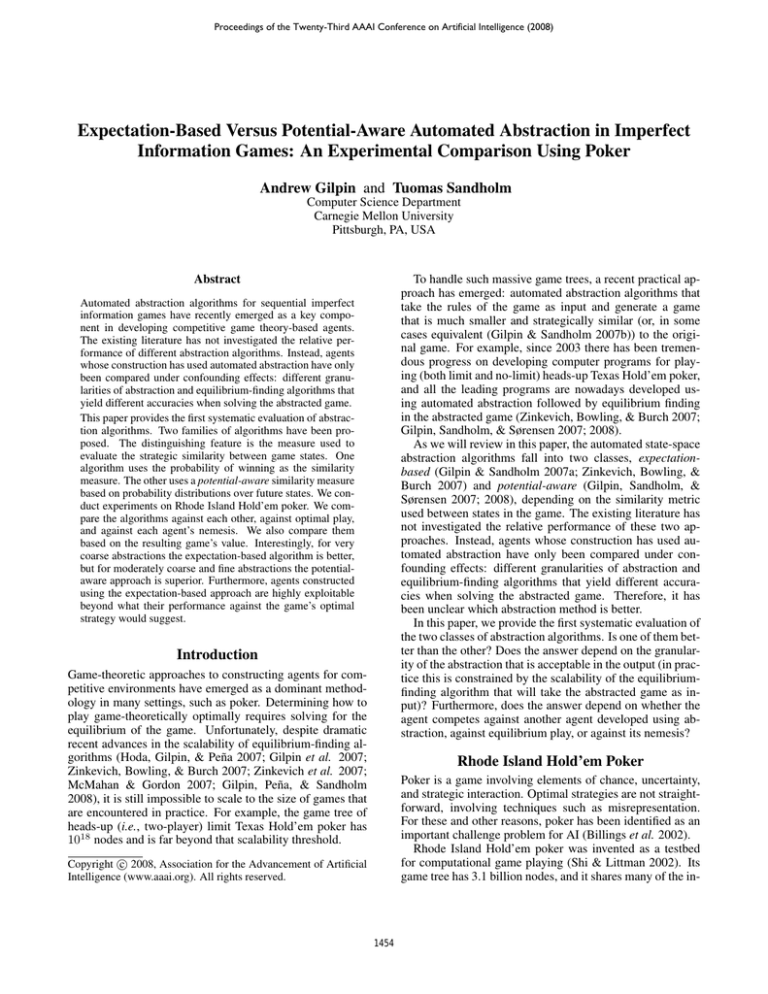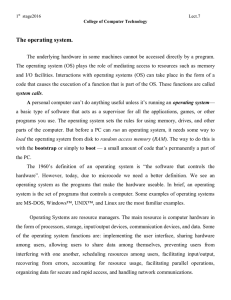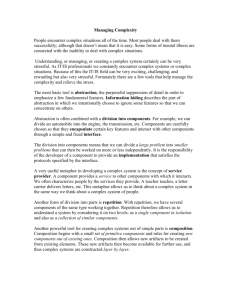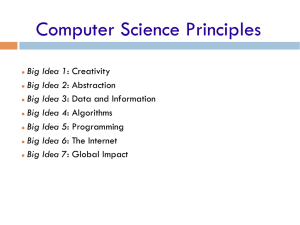
Proceedings of the Twenty-Third AAAI Conference on Artificial Intelligence (2008)
Expectation-Based Versus Potential-Aware Automated Abstraction in Imperfect
Information Games: An Experimental Comparison Using Poker
Andrew Gilpin and Tuomas Sandholm
Computer Science Department
Carnegie Mellon University
Pittsburgh, PA, USA
Abstract
To handle such massive game trees, a recent practical approach has emerged: automated abstraction algorithms that
take the rules of the game as input and generate a game
that is much smaller and strategically similar (or, in some
cases equivalent (Gilpin & Sandholm 2007b)) to the original game. For example, since 2003 there has been tremendous progress on developing computer programs for playing (both limit and no-limit) heads-up Texas Hold’em poker,
and all the leading programs are nowadays developed using automated abstraction followed by equilibrium finding
in the abstracted game (Zinkevich, Bowling, & Burch 2007;
Gilpin, Sandholm, & Sørensen 2007; 2008).
As we will review in this paper, the automated state-space
abstraction algorithms fall into two classes, expectationbased (Gilpin & Sandholm 2007a; Zinkevich, Bowling, &
Burch 2007) and potential-aware (Gilpin, Sandholm, &
Sørensen 2007; 2008), depending on the similarity metric
used between states in the game. The existing literature has
not investigated the relative performance of these two approaches. Instead, agents whose construction has used automated abstraction have only been compared under confounding effects: different granularities of abstraction and
equilibrium-finding algorithms that yield different accuracies when solving the abstracted game. Therefore, it has
been unclear which abstraction method is better.
In this paper, we provide the first systematic evaluation of
the two classes of abstraction algorithms. Is one of them better than the other? Does the answer depend on the granularity of the abstraction that is acceptable in the output (in practice this is constrained by the scalability of the equilibriumfinding algorithm that will take the abstracted game as input)? Furthermore, does the answer depend on whether the
agent competes against another agent developed using abstraction, against equilibrium play, or against its nemesis?
Automated abstraction algorithms for sequential imperfect
information games have recently emerged as a key component in developing competitive game theory-based agents.
The existing literature has not investigated the relative performance of different abstraction algorithms. Instead, agents
whose construction has used automated abstraction have only
been compared under confounding effects: different granularities of abstraction and equilibrium-finding algorithms that
yield different accuracies when solving the abstracted game.
This paper provides the first systematic evaluation of abstraction algorithms. Two families of algorithms have been proposed. The distinguishing feature is the measure used to
evaluate the strategic similarity between game states. One
algorithm uses the probability of winning as the similarity
measure. The other uses a potential-aware similarity measure
based on probability distributions over future states. We conduct experiments on Rhode Island Hold’em poker. We compare the algorithms against each other, against optimal play,
and against each agent’s nemesis. We also compare them
based on the resulting game’s value. Interestingly, for very
coarse abstractions the expectation-based algorithm is better,
but for moderately coarse and fine abstractions the potentialaware approach is superior. Furthermore, agents constructed
using the expectation-based approach are highly exploitable
beyond what their performance against the game’s optimal
strategy would suggest.
Introduction
Game-theoretic approaches to constructing agents for competitive environments have emerged as a dominant methodology in many settings, such as poker. Determining how to
play game-theoretically optimally requires solving for the
equilibrium of the game. Unfortunately, despite dramatic
recent advances in the scalability of equilibrium-finding algorithms (Hoda, Gilpin, & Peña 2007; Gilpin et al. 2007;
Zinkevich, Bowling, & Burch 2007; Zinkevich et al. 2007;
McMahan & Gordon 2007; Gilpin, Peña, & Sandholm
2008), it is still impossible to scale to the size of games that
are encountered in practice. For example, the game tree of
heads-up (i.e., two-player) limit Texas Hold’em poker has
1018 nodes and is far beyond that scalability threshold.
Rhode Island Hold’em Poker
Poker is a game involving elements of chance, uncertainty,
and strategic interaction. Optimal strategies are not straightforward, involving techniques such as misrepresentation.
For these and other reasons, poker has been identified as an
important challenge problem for AI (Billings et al. 2002).
Rhode Island Hold’em poker was invented as a testbed
for computational game playing (Shi & Littman 2002). Its
game tree has 3.1 billion nodes, and it shares many of the in-
c 2008, Association for the Advancement of Artificial
Copyright Intelligence (www.aaai.org). All rights reserved.
1454
Expectation-based Abstraction
teresting complications present in Texas Hold’em. Although
it has been solved optimally (Gilpin & Sandholm 2007b), it
remains useful in its intended role as a testbed.
Rhode Island Hold’em is a two-person zero-sum game.
Thus, the equilibrium problem can be formulated as a linear program whose size is linear in the size of the game
tree (Romanovskii 1962; Koller & Megiddo 1992; von Stengel 1996). Although solving these linear programs becomes
difficult in practice for large games, the scalability is adequate for the abstracted games (even losslessly abstracted
ones) we discuss in this paper. Hence, in our experimental
evaluations, we test against the optimal strategies for the abstracted games. The tractability of finding optimal strategies
under all granularities of abstraction is important because it
allows us to isolate the performance of the abstraction from
the performance of the equilibrium-finding algorithm (because the latter is exact here). This is the reason we use
Rhode Island Hold’em—which is just under the threshold
of what is solvable for equilibrium exactly—as the testbed,
instead of, say, Texas Hold’em.
Currently the most sophisticated expectation-based approach to automated abstraction (Gilpin & Sandholm 2007a)
uses a combination of k-means clustering (to estimate the
error of different buckets) and integer programming (to allocate the buckets). When we study expectation-based abstraction, we will focus our attention on that algorithm,
which we will now describe.
For the second round, the abstraction algorithm must determine how many child buckets each of the K1 first-round
buckets has, subject to the constraint of having at most K2
total children. Before determining how many children each
first-round bucket has, the algorithm estimates the error for
each first-round bucket having various numbers of secondround children. It does this using k-means clustering, where
the value of a hand is its winning probability (each tie counts
as half a win).
Once these errors have been computed for all first-round
buckets and for all possible values of k, the algorithm faces
the allocation problem of choosing how many children each
first-round bucket is allotted. (Once the number of children it can have is determined, the actual children it has
will be determined by the solution to the k-means clustering problems, which the clustering algorithm has stored.)
The algorithm solves this problem using a 0-1 integer program (Gilpin & Sandholm 2007a).
An analogous procedure, including the k-means clustering computations for calculating the errors and a 0-1 integer
program for allocating the buckets, is repeated for the third
betting round (with the K2 second-round buckets as the parents, and a limit of K3 on the maximum number of children).
Automated Abstraction
As mentioned above, two-person zero-sum sequential imperfect information games are solvable in polynomial-time
in the size of the game tree. However, even with recent advances in equilibrium-finding algorithms for solving such
games (Hoda, Gilpin, & Peña 2007; Gilpin et al. 2007;
Zinkevich, Bowling, & Burch 2007; Zinkevich et al. 2007;
McMahan & Gordon 2007; Gilpin, Peña, & Sandholm
2008), finding smaller, strategically similar representations
of games remains an important component technology in
the construction of game theory-based agents. The purpose of an automated abstraction algorithm is to perform this
“shrinking” operation and output a much smaller but strategically similar game.
In Rhode Island Hold’em, there are 52 distinct hands in
the first round, 52 · 51 = 2652 distinct hands in the second
round, and 52·51·50 = 132600 hands in the third round. The
output of an automated abstraction algorithm is a mapping
from these distinct hands to one of a number of buckets. The
number of buckets available at each of the three rounds is
parameterized by K1 , K2 , and K3 . In our experiments we
will vary the values of these parameters in order to observe
the relative performances of the abstraction algorithms as we
vary the granularity of the abstraction.
In our experiments, we fix the number of first-round buckets to be K1 = 13. This value allows for an optimal bucketing at that level; it can be obtained by simply applying suit
isomorphisms. Since each player only has one card and there
are 13 different ranks, we can find the optimal 13 buckets
by simply grouping the hands according to rank and ignoring the suit. Determining buckets for the second and third
rounds is thus the main part of the abstraction algorithms,
which we will discuss in the next two subsections. While
the algorithms are not specific to any game, for convenience,
we describe them in terms of how they apply to Rhode Island
Hold’em.
Potential-aware Abstraction
The automated abstraction algorithm presented in the previous subsection was based on a myopic expected-value
(specifically, probability of winning) computation. Unfortunately, that approach ignores certain strategically relevant
aspects of the game. In particular, it completely ignores the
potential of hands. For example, in Rhode Island Hold’em
poker, one high-potential hand is one in which the player
has two cards of a certain suit (three are required to make
a flush); at the present stage the hand is not very strong,
but could become so if the required card showed up later in
the game. Potential-aware automated abstraction (Gilpin,
Sandholm, & Sørensen 2007) addresses this issue. The basic
outline of the algorithm is the same as the expectation-based
abstraction algorithm described above. The primary difference is in the metric used in comparing the strategic similarity of two games states. Instead of using winning probability as the similarity measure, the potential-aware abstraction
algorithm associates with each hand a histogram over possible future states. The metric used to compare histograms
is the L2 -distance metric. Under this approach, another design dimension of the algorithm is in the construction of the
possible future states as we will discuss below.
Potential-aware Automated Abstraction for Round 2
Recall that the algorithm is going to use k-means clustering of histograms to estimate the errors of various buckets.
Before it can do the clustering, it must determine the future
1455
doing clustering in the higher-dimensional space of histograms. We used CPLEX’s interior-point linear programming solver for finding an exact equilibrium of each of the
abstracted games.
We compared the agents constructed with the two abstraction approaches using four different evaluation criteria. The
following three subsections discuss three of these.1
possible states for the histograms. The algorithm does this
for each first-round bucket by performing a bottom-up pass.
For each first-round bucket i, it examines the third-round
hands that contain as their first card one of the cards in firstround bucket i. Associated with each of these third-round
hands is a triple (w, l, d) corresponding to the number of
wins, losses, and draws a player expects when holding that
hand (based on a uniform roll-out of the opponent’s card).
The algorithm then performs a k-means clustering on these
histograms (over win, lose, and draw counts).
The centroids that this clustering operation outputs are
used as the future possible states for the second-round hands
(after the second-round clustering, these temporary states
are discarded). In particular, each second-round hand is associated with a histogram over these states. Next, as was
done in the expectation-based algorithm above, the algorithm performs the multiple k-means clusterings for various values of k to estimate the expected error of a particular
second-round bucket, given that it is allowed to have k children. Then, the second-round abstraction is computed by
solving a 0-1 integer program.
Comparing Agents in Head-to-head Play
The first criterion we use to compare the algorithms is to
simply play the resulting strategies against each other in the
full, unabstracted version of Rhode Island Hold’em. Formally, if (xEB , yEB ) is the pair of strategies computed by
the expectation-based algorithm and (xP A , yP A ) is the pair
of strategies computed by the potential-aware algorithm, the
expected payoff to the expectation-based player is
1 T
1
x AyP A − xT
AyEB .
2 EB
2 PA
As can be seen in Table 1, the potential-aware algorithm
beats the expectation-based algorithm for the abstraction
granularities 13-50-250 and finer. However, interestingly,
there is a cross-over: the expectation-based algorithm beats
the potential-aware algorithm for the coarsest granularity
13-25-125. One hypothesis for why this is the case is that the
dimensionality of the temporary states used in the bottomup pass in the third-round (which must be smaller than the
the number of available second-round buckets in order for
the clustering to discover meaningful centroids) is insufficient for capturing the strategically relevant aspects of the
game. Another hypothesis is that since the potential-aware
approach is trying to learn a more complex model (in a
sense, clusters of paths of states) and the expectation-based
model is trying to learn a less complex model (clusters of
states, based on mere probability of winning), the former
requires a larger dimension to capture this richness.
Potential-aware Automated Abstraction for Round 3
In round 3, each hand is associated with a triple (w, l, d)
representing the number of wins, losses, and draws for each
hand. The algorithm simply runs the multiple k-means clusterings, followed by the integer program with resource limit
K3 , to determine the third round abstraction.
Experiments
In this section we present our experimental results comparing the expectation-based and potential-aware abstraction algorithms while varying the granularity of the abstractions. We denote an abstraction with K1 first-round buckets, K2 second-round buckets, and K3 third-round buckets
with the string K1 -K2 -K3 . For example, the abstraction
granularity 13-25-125 has 13 first-round buckets, 25 secondround buckets, and 125 third-round buckets. The abstraction
granularities we consider range from coarse (13-25-125) to
fine (13-205-1774). At this fine granularity an equilibriumpreserving abstraction exists (Gilpin & Sandholm 2007b).
For two-person zero-sum sequential imperfect information games with perfect recall, the equilibrium problem is to
find a solution to
max min xTAy = min max xTAy,
x∈Q1 y∈Q2
Comparing Agents against Equilibrium Play
The second evaluation criterion is to play each of the abstractions against the optimal strategy (i.e., equilibrium
strategy) of the unabstracted game. If (x, y) is the pair of
strategies computed by one of the abstraction algorithms and
(x∗ , y∗ ) is the optimal pair of strategies for the unabstracted
game, the expected payoff to the abstracted player is
1
1 T
x Ay∗ − xT
Ay.
2
2 ∗
The results in Table 1 show that, as expected, both algorithms improve against the optimal strategy as finer-grained
abstractions are allowed. Furthermore, the potential-aware
algorithm has a better payoff than the expectation-based
algorithm for granularity 13-50-250 and finer, and is optimal for the 13-205-1774 granularity, indicating that the
potential-aware algorithm finds the a lossless abstraction.
(In fact, we verified that it finds the same abstraction
as the GameShrink algorithm that finds lossless abstractions (Gilpin & Sandholm 2007b).) In contrast, we see that
y∈Q2 x∈Q1
where Qi is the set of realization plans for player i and A is
the payoff matrix. The sets of realization plans are derived
from the sequence form representation of the game (Koller
& Megiddo 1992; Romanovskii 1962; von Stengel 1996).
In the experiments we will use (x∗ , y∗ ) to denote an optimal solution to Rhode Island Hold’em, and we will use
(xEB , yEB ) and (xP A , yP A ) to denote strategies for Rhode
Island Hold’em computed using the expectation-based (EB)
algorithm and the potential-aware (PA) algorithm, respectively, for a given level of granularity.
Compared to the time for finding equilibria, the time
needed by the abstraction algorithms was insignificant, although the potential-aware algorithm takes slightly longer
than the expectation-based algorithm since the former is
1
Our results for the fourth criterion, estimating the value of the
game, are available in an extended version of this paper. Those
results are basically the same as under the other three criteria.
1456
Granularity
13-25-125
13-50-250
13-100-750
13-150-1250
13-205-1774
Experiment 1
EB Payoff
PA Payoff
16.6223
-16.6223
-1.06272
1.06272
-6.988
6.988
-5.5703
5.5703
-0.0877339 0.0877339
Experiment 2
EB Payoff
PA Payoff
-25.0312
-41.7910
-19.6519
-18.2612
-11.9801
-5.42475
-6.81724
-1.57695
-0.0877339
0.0
EB Payoff
-160.527
-134.406
-68.8882
-59.1117
-0.429457
Experiment 3
PA Payoff
-204.022
-125.972
-45.1235
-12.067
-0.000460
PA - EB
-43.495
8.434
23.7647
47.0447
0.428997
Table 1: Comparison of expectation-based (EB) and potential-aware (PA) abstraction against each other (Experiment 1), against
the optimal strategy (Experiment 2), and against their nemeses (Experiment 3).
the expectation-based algorithm never finds a lossless abstraction, regardless of how fine an abstraction we allow it to
make. This is due to the fact that sometimes two game states
have exactly the same probability of winning, yet should be
played differently.
equilibrium-finding algorithms more scalable so games with
finer-grained abstractions become solvable, the potentialaware approach will become the method of choice.
Acknowledgments
This material is based upon work supported by the National
Science Foundation under ITR grant IIS-0427858. We also
acknowledge Intel Corporation and IBM for their gifts.
Comparing Agents against Their Nemeses:
Worst-case Performance
References
The third criterion examines the expected worst-case performance of the algorithms. This is done by computing a
best response strategy—i.e., a nemesis—for each of the two
strategies, and then playing each strategy against its nemesis. If (x, y) is the strategy pair computed by one of the
abstraction algorithms, the expected worst-case payoff is
1
1
min xTAv + max uTAy.
2 v∈Q2
2 u∈Q1
Table 1 shows that the performance guarantees of each
of the algorithms improve as finer abstraction is allowed. Again, the potential-aware algorithm outperforms
the expectation-based algorithm for abstraction granularities
13-50-250 and finer, but the expectation-based algorithm
provides a better bound for the coarsest granularity.
Billings, D.; Davidson, A.; Schaeffer, J.; and Szafron, D. 2002.
The challenge of poker. Artificial Intelligence 134(1-2):201–240.
Gilpin, A., and Sandholm, T. 2007a. Better automated abstraction
techniques for imperfect information games, with application to
Texas Hold’em poker. In AAMAS’08.
Gilpin, A., and Sandholm, T. 2007b. Lossless abstraction of
imperfect information games. Journal of the ACM 54(5).
Gilpin, A.; Hoda, S.; Peña, J.; and Sandholm, T. 2007. Gradientbased algorithms for finding Nash equilibria in extensive form
games. In WINE’07.
Gilpin, A.; Peña, J.; and Sandholm, T. 2008. First-order algorithm
with O(log(1/)) convergence for -equilibrium in games. In
AAAI’08.
Gilpin, A.; Sandholm, T.; and Sørensen, T. B. 2007. Potentialaware automated abstraction of sequential games, and holistic
equilibrium analysis of Texas Hold’em poker. In AAAI’07.
Gilpin, A.; Sandholm, T.; and Sørensen, T. B. 2008. A heads-up
no-limit Texas Hold’em poker player: Discretized betting models and automatically generated equilibrium-finding programs. In
AAMAS’08.
Hoda, S.; Gilpin, A.; and Peña, J. 2007. A gradient-based approach for computing Nash equilibria of large sequential games.
Available at http://www.optimization-online.org/.
Koller, D., and Megiddo, N. 1992. The complexity of two-person
zero-sum games in extensive form. Games and Economic Behavior 4(4):528–552.
McMahan, H. B., and Gordon, G. J. 2007. A fast bundle-based
anytime algorithm for poker and other convex games. In 11th Int.
Conf. on Artificial Intelligence and Statistics (AISTATS).
Romanovskii, I. 1962. Reduction of a game with complete memory to a matrix game. Soviet Mathematics 3:678–681.
Shi, J., and Littman, M. 2002. Abstraction methods for game
theoretic poker. In CG ’00: Revised Papers from the Second International Conference on Computers and Games, 333–345.
von Stengel, B. 1996. Efficient computation of behavior strategies. Games and Economic Behavior 14(2):220–246.
Zinkevich, M.; Bowling, M.; Johanson, M.; and Piccione, C.
2007. Regret minimization in games with incomplete information. In NIPS’07.
Zinkevich, M.; Bowling, M.; and Burch, N. 2007. A new algorithm for generating equilibria in massive zero-sum games. In
AAAI’07.
Conclusions and Discussion
We provided the first systematic comparison of automated
abstraction algorithm for sequential imperfect information games. We examined two families of algorithms:
expectation-based and potential-aware. Our experiments,
conducted using the game of Rhode Island Hold’em poker
(in order to isolate the abstraction issues from confounding
effects), examined four criteria. The results were consistent
across all four criteria. For extremely coarse abstractions,
expectation-based abstraction performed the best. As the abstraction granularity becomes finer, the potential-aware algorithm outperformed the expectation-based algorithm, and
was optimal in the limit. Interestingly, players generated using expectation-based abstraction are much more exploitable
(by the nemesis) than the head-to-head comparisons against
potential-aware abstraction would suggest.
Currently, the most successful heads-up Texas Hold’em
poker-playing programs employ some form of automated
abstraction followed by equilibrium computation in the abstracted game. Until now, it was not clear which method of
abstraction was better. In this paper, we have shed some
light on this question. Based on our experiments, it appears that for coarse abstractions, expectation-based is the
best approach, and for fine-grained abstraction, potentialaware abstraction is superior. Thus, for a given game—
such as Texas Hold’em—as computers become faster and
1457






